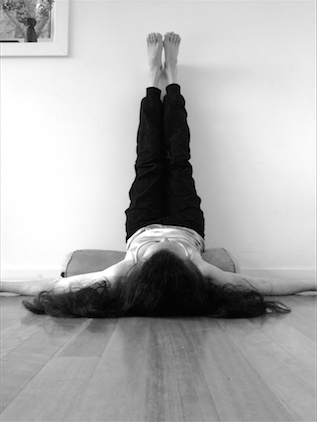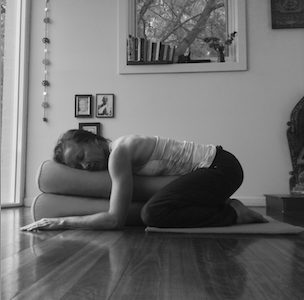Renew You
I haven’t always been attracted to restorative postures. Generally I am one to be drawn to a physical practice where I feel my body stretch and move. But, I will admit there have been a few times where nothing else will do than a good rest in a restorative position.
Perhaps the first time when I really felt this was a period of transition where I felt mentally and emotionally exhausted, and a deep sense to draw in. Later it was my first pregnancy that drew me to a restorative practice. Now, I will use them regularly as I need.
Restorative postures refresh, renew and allow reflection. They allow the senses to still. They assist in balance returning to the body. Their supported nature allows tension to leave the body on all levels - physical, mental and emotional.
What happens when we are stressed?
The adrenals release adrenaline and noradrenaline which act upon the sympathetic nervous system and induce a response of ‘flight or fight’. The heart rate and blood pressure go up, we are hyper alert and muscles tense. Systems not necessary in the immediacy of the moment shut down…. Systems like metabolism and elimination, growth, repair and reproduction.
If we hold onto stress and accumulate it within our bodies long term there can be implications to our health. Issues like high blood pressure, ulcers, immune dysfunction, reproductive problems, and depression can be related to stress. There can be many circumstances that contribute to stress - work, relationships, worry, anxiety, overwhelm, exhaustion, or a period of change like pregnancy or menopause.
What happens when we feel supported?
When we are physically supported muscle tension can leave our body and as that happens the breath returns to normal, our hormones return to normal and that fight or flight response (the sympathetic nervous system) can take a break bringing blood flow and energy back to things like digestion and repair. Mentally the mind becomes quiet. Emotionally our load that we are carrying (the big and little things that stress us) don’t feel quite so heavy and we are able to respond, rather than react, to situations.
Why restorative postures work.
• The props provide a completely supported environment where the body and mind can feel safe.
• The postures gently target different parts of the body, moving the spine in different directions, gently stimulating or soothing different organs to assist hormone balance.
• Inversions assist in venous return of blood and lymph and rest the heart.
•Postures support full relaxed breathing.
•Postures induce introversion, helping the mind turn in, down and back.
•They leave the practitioner feeling refreshed, neither overstimulated nor depleted.
Here are three of my favourite restorative postures.
You can make these as simple or as complex as you like, but the idea is to feel supported. A good indication that you need more support is if you feel uncomfortable, a stretching or straining. Take your time to get it right - even raising or lowering by a centimetre or two can make a difference.
Viparita Karani (legs up the wall)
Simply it is resting the legs up a wall, the back on the floor, and letting gravity do the rest. This pose is great for refreshing tired legs and mind. It reduces the systemic effects of stress. It also assists in venous return of blood and lymph from the legs back to the abdomen, thus being helpful to those who stand for long periods or suffer from fluid retention or varicose veins.

The hardest thing is getting into the posture. Sit side on, close to the wall. Roll your back to the floor and swing your legs up. Wriggle closer if you can and if your back and legs allow. You can place support under the head and neck if you wish. You can also place a bolster under the hips if you wish - just bend the knees and press the feet to the wall to lift the hips and slide the bolster under. Take a moment to check that you are straight, that the head, hips and legs are in line.
Then rest for 5 or 10 minutes.
When you are ready to come out of the posture raise your hips and remove the bolster if you are using one, return the spine to the floor and rest with
the knees bent, feet on the wall for a few minutes to
let the back neutralise. Then, roll onto your side
and come up to sitting.
This posture is not recommended for those people
who should avoid inversions.
Supported Baddhakonasana (Supine Bound Angle Pose)
This is another favourite and full of many benefits. Physically, it gently opens the chest, abdomen and hips. Psychologically it takes us to a space where we feel safe, supported, and nurtured.

This posture benefits people with breathing problems, high blood pressure and dealing with stress, as it gently opens and releases tension across the chest and shoulders. It is also helpful with digestive problems, indigestion and during menstruation and menopause.
Again this can be as simple as lying back, bringing
the soles of the feet together and dropping the knees to the side. Or, with more support - a bolster under the length of the spine, the edge brought right up to the sacrum. A block under the head end of the bolster to raise the head slightly, a folded blanket would do the same. Supports can also go under the knees/ thighs and even under the forearms. If you feel a strain in the groin use more support under the legs. If there is a strain on the back raise the bolster height, or lie flat on the floor. If there is a strain on the chest and shoulder raise the support under the arms. Taking your time to get it right means you can stay and relax rather than fight the posture.
To come out of the posture bring the knees up, Remove the bolster under the spine and rest with the back flat on the floor, separate the feet and prop the knees together. Let the back and groin neutralise before you turn to the side and come up to sitting.
Be cautious with this posture if you have neck, back, sacrum or knee issues.
Supported Balasana (Supported Child’s Pose)
This posture gently stimulates the parasympathetic nervous system, 'rest and digest’, bringing homeostasis back to the body. It also gently stretches the lower back. A familiar posture of rest for young children, it induces calming introversion.
There is enough support under the body so that the knees and hips are comfortable. Start by kneeling on the floor, bring the end of the bolster

or folded blankets between the knees. Lengthen the torso down over the length of the supports. Lie the head to the side and tip the chin towards the chest. Let the tailbone drop towards the heels, though it is not necessary that they touch, and there is not much weight on the legs.
If there is discomfort in the ankles try a rolled towel under the ankle. If there is discomfort in the knees, try a rolled towel in the back of the knee, or raise the height of the support. If there is trouble breathing move the top support forward so you rest on the sternum and the belly can freely expand. Rest your arms either forward or back, letting the shoulders release away from the ears. Be sure to turn your head to the other side part way through to keep the neck balanced.
When you are ready to come out press the hands into the floor to lift the torso off the supports. Sit to the side of the heels and straighten the legs letting the knees and ankles return to normal.
Do not practice this posture if you have chronic neck, back or knee issues.
The beautiful thing about these postures is that five or ten minutes can make a big difference. The next time you find yourself with a little time try one or two of these instead of looking for a distraction. Definitely a worthy addition to your repertoire of self care.